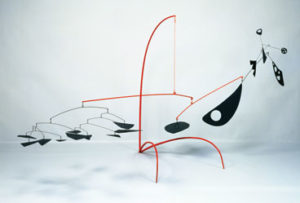By combining art and science, we can create powerful learning experiences that foster curiosity, understanding, and appreciation for the world around us.
In the early 1920s, Niels Bohr was struggling to reimagine the structure of matter. Previous generations of physicists had thought the inner space of an atom looked like a miniature solar system with the atomic nucleus as the sun and the whirring electrons as planets in orbit. This was the classical model.
But Bohr had spent time analyzing the radiation emitted by electrons, and he realized that science needed a new metaphor. The behavior of electrons seemed to defy every conventional explanation. As Bohr said, “When it comes to atoms, language can be used only as in poetry.” Ordinary words couldn’t capture the data.

Black Peacock, 1950
ALEXANDER CALDER
This mobile is a powerful example of how an art form can be tailored to the physiology of a specific area in the brain. Calder’s composition anticipated, artistically, the physiological properties of the cells of an area called V5, which are selectively responsive to motion and its direction. Viewed from a distance, the separate pieces of the mobile appear as static spots of varying sizes. But as the pieces move in different directions, each one stimulates only the category of cell that is selectively responsive to the direction in which the spot is moving.
Supporting methods of science learning that are connected to imagination and artistic process can change the world of science and industry in future. Implementing such methods in interactive learning, can extend and develop innovative practices in science education. Building toys in an educational framework can help students to express their ideas on observed phenomena and compare them as the starting point in building their scientific knowledge. Encouraging students to build toys and explain the science behind them in a cooperative atmosphere can lead to innovation and will help to create new industries in the future.
Imagination in Science by Art in different Cultures (ISAC) Talk, is an international Community.
It started with the sparks of our own interests in Ariaian Young Innovative Minds Institute (AYIMI) and ADIB Science and Technology Institute (ADIB) jointly, to excite others by fascinating topics hoping that enthusiasm comes through for all who are working in science and art but with different cultures.
To inspiring all to fall in love with science needs to know the art which can be combined with it. To improve this community, it should be accessible to others and creating more documents that’s much better anyone can use. To keep going we should hear the story of students, teachers and faculties then making a clear service across the countries who are interested to join this community. This collaboration may lead us to remove constraints that push our students and teachers to be creative.
ISAC Talk Community Structure which should be clearly identified and introduced on the website and social media is divided in different working groups as follows:
